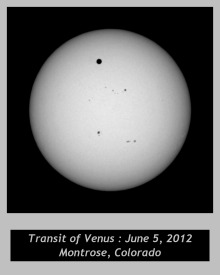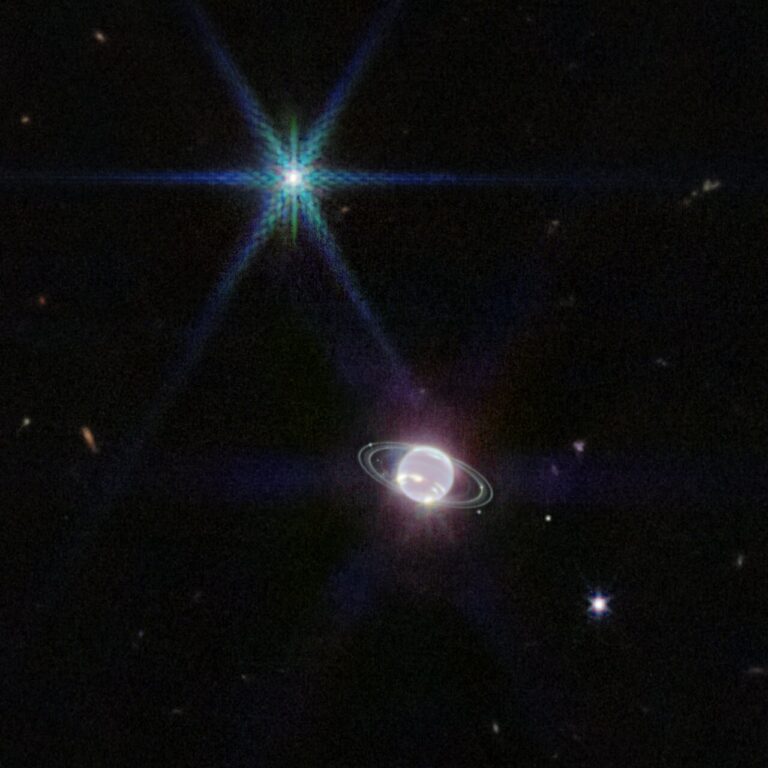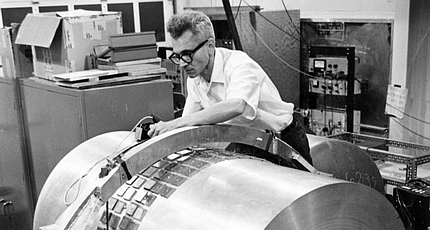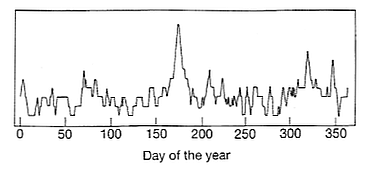
This Month in the History of Astronomy - June
- Jun 3, 1900 - Adelaide Ames, American astronomer and
co-author of what would become known as the Shapley-Ames Catalogue
of Galaxies.
After graduating from Vassar College in 1922, Ames went on to
Radcliffe, becoming a research assistant under Harvard College
Observatory director Harlow Shapley the next year, and then
becoming the first woman to earn an M.A in astronomy in 1924.
Her work was primarily in the cataloging of galaxies in the
constellations Coma and Virgo. Much of this work was done with
a Zeiss Tessar lens, probably a "IIb" f/6.3 with F=360mm, as
the scale was said to be 10 arc-minutes per millimeter (implying
F=345mm), so the galaxies were so small and almost star-like that
their brightnesses could easily be compared to stars on the same
plate. The lens front element is listed as being only 61 mm
in diameter -- less than 2½ inches.
In 1931, the finished catalog, A Survey of the External Galaxies
Brighter Than the Thirteenth Magnitude was published, included
nearly 2800 objects. This would become known as the Shapley-Ames
Catalogue, and, later, after additions and extensions, as the
Revised Shapley-Ames Catalogue of Bright Galaxies, which is still
a valuable reference and in use nearly a century later. The
intrinsically brightest galaxies, at the faintest level, are
~500 Mega-parsecs distant (~1½ billion light years.)
Ames would die shortly after the catalogue came out, when her
canoe over-turned on a lake while vacationing in the Summer of
1932. There was always a bit of a mystery surrounding the
accident, as she was reputed to be an excellent swimmer and
her companion in the canoe made it safely to shore.
- Jun 8, 1625 - Giovanni Cassini, the most notable early
observer following Galileo. An Italian who headed the Paris Observatory
for many years, Cassini was the first to observe seasonal changes on
Mars and measure this planet's parallax (or distance), setting the
scale of the solar system for the first time. He was the first to
describe the bands and spots on Jupiter, and studied the Jovian moons'
orbits. He discovered four moons of Saturn, but is best remembered for
first seeing the division (now named after him) between Saturn's A and
B rings.
- Jun 9, 1812 - Johann Gottfried Galle, German observer who
first saw Neptune. Galle is also noteworthy for having been Encke's
assistant, and he's one of the few astronomers ever to have observed
Halley's Comet twice -- dieing two months after the comet passed
perihelion in 1910.
- Jun 17, 1888 - Alexander Alexandrovich Friedmann,
mathematician and cosmologist who published the first expanding,
or non-static, models of the universe based on Einstein's general
relativity. These originated in a singularity (size of the universe
equals zero), so Friedmann was the first to hint at the Big Bang and
use the phrase "the time since [the] beginning of the world" -- the
age of the universe.
The paper went largely unnoticed for almost a decade, until Hubble
had established his distance-velocity relationship (Hubble's Law),
though Einstein did correspond with him, saying, "I am convinced Mr.
Friedmann's results are both correct and clarifying. They show that
in addition to the static solutions to the field equations [his and
de Sitter's] there are time varying solutions with a spatially
symmetric structure."
Friedmann also worked in meteorology, and in 1925 went on a balloon
flight to study the upper atmosphere that set a Soviet altitude
record (7.4 km, or more than 24,000 feet). He died two months later,
probably of typhus of the stomach.
- Jun 18, 1818 - Angelo Secchi, Italian astronomer who
was one of the first to apply spectroscopy to the study of stars,
conducting a sky survey of more than 4,000 of them and coming up
with an early spectral classification system based on four groups,
which he incorrectly attributed to differences in chemical
composition (1867).
Secchi was also an early researcher into the use of photography in
astronomy. By 1859 he had a complete set of telescopic photos covering
the moon, and photographed the total eclipse of July 18, 1860.
Besides being an active observer of double stars, Secchi also
proved that solar prominences were appendages on the Sun.
Secchi also worked out that the orbital period of a comet reaching
halfway to the nearest star at its aphelion would be on the order of
100 million years, at that time the longest timescale astronomers had
ever considered.
- Jun 21, 1863 - Maximilian Franz Joseph Wolf, an astronomer
based in Heidelberg, Germany, who discovered over 200 asteroids. At
age 20, Wolf discovered a new comet with a period of 7.7 years. At a
time when small bodies in the solar system were discovered visually,
he invented the then new photographic technique whereby stars were
recorded as pinpoints but rapidly moving objects like comets and
asteroids would appear as short streaks during the time exposures.
He also invented the "blink comparator" (or stereo-comparator), in
which two plates taken some time apart could be alternately presented
to the two eyes in rapid succession, so that objects which moved
between the two exposures would appear to jump back and forth, and
variable stars would grow and shrink in size, a very effective method
for discovering such objects, especially in crowded star fields.
Wolf discovered the first Trojan asteroid (Achilles), confirming
the advances in celestial mechanics and mathematics pioneered by
Lagrange. He developed independently of Barnard the idea that the
voids or dark regions in the Milky Way were not star gaps but regions
of obstruction, now known to be due to instellar gas clouds containing
dust, and discovered the North American Nebula in Cygnus. Wolf was
also the first to pick up Halley's Comet when it came around in 1909.
Over a thirty year period (1895-1926), Wolf turned up four of the
first nineteen supernovae discovered in other galaxies. As if all
that wasn't enough, Wolf discovered (1909) what's now called the
Wolf-Lundmark-Melotte (WLM) dwarf irregular galaxy in western Cetus,
the latter two independently coming across it eight years later;
it's a distant and isolated member of the Local Group of galaxies.
- Jun 21, 1915 - Wilhelm Gliese, German astronomer who
specialized in the study and cataloging of nearby stars, found
primarily from proper motion surveys. His catalog was first
published in 1957, with a revised and updated version in 1969.
Two supplements appeared in 1979 and 1991.
- Jun 22, 1675 - Founding of the Royal Greenwich Observatory.
- Jun 24, 1883 - Victor Hess, Austrian-born experimental
physicist who discovered cosmic rays and shared in the 1936 Nobel
Prize with Carl Anderson, who had discovered the positron
(anti-electron) while studying cosmic rays. (Anderson discovered
the meson that same year.) The term 'cosmic ray' had been coined
by Robert Millikan in 1925.
Hess built on the work of Theodor Wulf, who had discovered (1910)
that the degree of ionization in the atmosphere increases with
altitude -- by taking an electroscope up the Eiffel Tower -- and
concluded the source of the ionization was of an extra-terrestrial
origin. Hess then made a dozen balloon ascents (1911-12), reaching
a height of 16,000 feet, where the ionization is 4x what it is at
ground level, even making an ascent at "night", during
the Apr 17, 1912, solar
eclipse; from this he showed the sun was not the source of the
ionization.
By 1931, after two years in the U.S. working on issues related
to radioactivity with both a radium producer and the Dept. of the
Interior's Bureau of Mines, Hess became professor of physics at
Innsbruck University, director of its Institude of Radiology, and
established a cosmic ray observatory on nearby Hafelekar Mountain.
Hess was forced to flee to the U.S. by the Nazi occupation of
Austria in 1938 because his wife was Jewish, and he spent the rest
of his life based in New York, including nearly twenty years as
professor of physics at Fordham University, after becoming a U.S.
citizen during World War II.

- Jun 24, 1915 - Fred Hoyle, British astrophysicist who
was instrumental in the development of the theory of stellar
nucleosynthesis, and who coined the term "big bang" to describe
a cosmology he disliked, being an inventor of, and a chief
proponent for, the rival steady state theory.
In what can only be described as an act of inspired brilliance,
Hoyle, realizing that something special was needed to make it
possible for evolved stars to synthesize carbon from helium,
predicted the existence of a nuclear resonance energy level
that was subsequently found right at the energy he'd calculated,
making the otherwise impossible triple-alpha process "go".
Hoyle held the Plumian chair at Cambridge, as had people like
George Darwin and Arthur Eddington.
- Jun 25, 1894 - Hermann Oberth.
- Jun 26, 1730 - Charles Messier, famed French comet hunter,
who cataloged the 100 or so bright nebulae and star clusters known
nowadays by their M numbers because he kept confusing these stationary
objects with possible new comets, which is what he was really after.
- Jun 26, 1914 - Lyman Spitzer, U.S. theoretical astrophysicist
who concentrated on the interstellar medium and star formation. Spitzer
got his education and was at Yale from 1931-47, except for a year at
Cambridge as a student of Arthur Eddington, before moving to head
Princeton's astronomy and astrophysics department.
Namesake of the Spitzer infrared space telescope (2003), in honor of
his early advocacy for space telescopes in general and being a steadfast
proponent for fifteen years -- 1963 until its funding in 1978 -- for
what became the Hubble Space Telescope.
- Jun 27, 1767 - Alexis Bouvard, French astronomer and
mathematician. Director of the Paris Observatory, after having been
a student there under Pierre-Simon Laplace.
Bouvard discovered eight comets and determined their orbits. His careful
observations of the irregularities in the motion of Uranus, and his
hypothesis of the existence of an eighth planet in the solar system,
led to the calculations by John Couch Adams and Urbain Le Verrier which
resulted in Neptune's discovery a few years after his death in 1843.
- Jun 29, 1868 - George Ellery Hale, solar astronomer,
discoverer that sunspots had magnetic fields, and inventor -- at
the age of 21 -- of the spectroheliograph. He was the founder of
the Astrophysical Journal.
Hale is the namesake of the 5-meter (200") telescope on Mt. Palomar,
and helped found the Yerkes, Mt. Wilson, and Palomar Observatories.
The 5-m was dedicated on June 3, 1948 and continues to be the largest
telescope in the continental 48 states.

Discoveries and other firsts
- Jun 5, 2012 - The date of the last transit of Venus,
among the rarest of predictable astronomical phenomena. In the
photo at right, north is roughly up and the direction of Venus's
motion was from about 11 o'clock towards 3 o'clock; the entire
transit took about 6½ hours. The next transit visible from
earth won't happen until December 2117.
- June 8, 1918 - Nova Aquilae 1918, first seen by Polish
medical professor and amateur astronomer Zygmunt Laskowski, is
confirmed by UK amateur Grace Cook. Peaking at a visual magnitude
of -½, it was the brightest new star to appear in the sky
since Kepler's supernova (1604) and was brighter than every other
star in the sky except Sirius and Canopus.
At a distance of 310 parsecs, in 1964 Robert Kraft determined the
now faded star of about the 11th magnitude was an eclipsing binary,
and thus originated the modern theory that all common novae (or
"cataclysmic variables" as they're often called) occur in a mass
transfer, close binary system containing a white dwarf. Nova
Aquilae 1918 has a period of only 3 1/3 hours.
- June 9, 1803 - William Herschel presents a paper to the
Royal Society establishing that close double stars are physically
bound binaries in orbit around each other and not just chance
alignments.
Herschel had started out two dozen years earlier with an entirely
different goal in mind: trying to measure a star's parallax. The
idea was that if all stars are instrinsically about the same
brightness then the fainter star in a close pair could be taken
to be a fixed reference point at infinity, and the parallax of
the brighter, closer star could be measured relative to it. After
two decades it became clear the motion for some of his sample was
orbital not parallactic.
- June 9, 1982 - Dr. Edward F. Guinan of Villanova
University announces the discovery of two rings around Neptune
at the annual summer meeting of the American Astronomical Society,
after re-examining photographic data gathered at a New Zealand
 observatory in 1968 with Craig C. Harris and Frank P. Maloney.
observatory in 1968 with Craig C. Harris and Frank P. Maloney.
Subsequent observations when Neptune occulted a star suggested the
rings might not be complete, but consist of segments or arcs. The
Voyager 2 spacecraft resolved the issue in its Aug 25, 1989, flyby,
showing three main rings, plus two more bordering the
middle one; the outermost, named the Adams Ring, consisted of
five pieces, explaining the earlier inconsistent occultation
observations.
[Photo at right shows Neptune in the IR from the James Webb Space
Telescope, with two of the rings clearly visible; the moon Triton
is above and to the left. Neptune is dark because its methane
atmosphere absorbs strongly at the IR wavelength used.]
- June 9, 1988 - Pluto occults a 12th magnitude star and
the light curve measured by eight groups definitively showed Pluto
to have an atmosphere.
Updated, last-minuted astrometry allowed the Kuiper Airborne
Observatory, led by J. Elliot, to track the centerline of Pluto's
shadow across the South Pacific Ocean for 2½ minutes. The
high time resolution thus achieved led to the discussion of
possible dusty haze or photochemical aerosol layers and thermal
gradients.
The atmosphere has an extent almost comparable to Pluto's radius
(1150 km), with a scale height of ~60 km, and a half-light
temperature and pressure of 67°K and 0.78 microbars, for
an assumed pure CH4 (methane) atmosphere. Methane
had previously been observed in the spectrum of Pluto, but it
wasn't clear if it was a solid on the surface or in the gaseous
form above it (or some combination); the occultation showed that
most of the spectral signature is due to a frozen methane surface.
The half-light level corresponds to ~125 km above the surface, or
about an eighth of the atmosphere's measurable extent.
- June 11, 2008 - Launch of the Fermi gamma-ray
observatory.
- Jun 12, 1894 - Oliver Lodge, Professor of Physics and
Mathematics at the University of Liverpool, makes the first known
attempt to detect extraterrestrial radio waves, from the sun, but
gets an inconclusive (null) result. The theory of the sun's corona
had first been worked out the previous year by German physicist
Hermann Ebert, though there was uncertainty then as to whether
any radio wavelength radiation would penetrate the earth's
atmosphere. By then it was known from laboratory experiments that
radio waves could be absorbed by rarefied gases, so there was
speculation that the upper atmosphere (of either the earth or
sun) might be radio opaque. There were several other unsuccessful
attempts over the following decade to detect the sun at radio
wavelengths, but then the matter was dropped and it was not
until World War II and the development of radar receivers that
this was done.
When Heinrich Hertz died prematurely of cancer in 1894, Lodge,
who was working on similar 'Hertzian wave' detection equipment,
gave an honorary lecture and demonstration at the Royal
Institution of London, where he stated his hope "to try for
long-wave radiation from the Sun" shortly. It would be several
decades before Karl Jansky and Grote Weber again took up the
task of detecting extraterrestrial radio waves, though during
the close Mars opposition of 1924 the U.S. Army Signal Corps
did try to tune in on any Martian broadcasts, following
unsubstantiated reports from both Nikola Tesla and Guglielmo
Marconi about having received signals possibly from Mars.
Jansky detected the Milky Way at radio wavelengths more than
a decade before radar operators during WWII picked up static
which was logically due to the sun, since enemy planes would
often attack with the sun at their backs in order to be
difficult to see.
- Jun 13, 1983 - Pioneer 10 becomes the first manmade
object to leave the solar system, in the direction of the
constellation Taurus.
- Jun 16, 1794 - A widely seen meteorite fall occurs
near Siena, Italy, at around 7 PM, showering the outskirts of
town with stones. A local professor, Ambrogio Soldani writes
up a 300 page book documenting the hundreds of eyewitness
accounts.
- Jun 16, 1806 - The Spaniard José Joaquin de
Ferrer, observing an eclipse in Kinderhook, NY, first uses
the term "corona" to describe the outer atmosphere of the sun
visible during a total eclipse.
- Jun 16, 1963 - Valentina Tereshkova became the first
woman ever to go into space, aboard the USSR's Vostok 6. Her
solo flight is still unique. Twenty years later, on the 18th,
Sally Ride became the first American woman in orbit, aboard the
Space Shuttle.

- Jun 22, 1968 - Joseph Weber announces the detection of
a gravity wave using his aluminum cylinder detector (photo at right),
but the result could not be confirmed.
Weber's detector was a 1-meter aluminum cylinder rigged with numerous
piezo-electric contact microphones, acting like a small seismometer
network, to sense any acoustic vibrations (quakes) created in the
cylinder by the passage of a spacetime distorting gravitational wave
in the aluminum.
- Jun 22, 1978 - James Christy of the US Naval Observatory
in Flagstaff, AZ, discovered Pluto's satellite Charon, about which
very little was known until the flyby of 2015 by the New Horizons
spacecraft. Pluto itself was discovered in Flagstaff (at the Lowell
Observatory, only 4 miles away) in 1930.
- Jun 22, 2019 - An incoming asteroid that hit the earth,
with a diameter of only 4 meters, is spotted and tracked in realtime
for the first time by the Asteroid Terrestrial-impact Last Alert
System (ATLAS) and the second Pan-STARRS telescope. Twelve hours
later the Nexrad weather radar in San Juan, Puerto Rico, recorded
the asteroid burning up in the atmosphere over the ocean.

- Jun 22-26, 1975 - Seismometers left on the moon by Apollo
astronauts record more large meteoroid strikes in a five-day period
than were detected over an entire five-year period of operation. The
estimated size of the impacting boulders was about one ton, and would
have created a spectacular fireball shower on earth, except that it
occurred on earth's dayside and went otherwise undetected. It is
thought the event was associated with the Beta Taurid meteor shower.
[Graph at right shows average daily number of meteoroids hitting the
moon from 1972-76.]
- Jun 24, 1881 - Sir William Huggins, one of the most
prominent British astronomers of the late Victorian era, makes
the first photographic spectrum of a comet (1881 III) and discovers
cyanogen (CN) emission at violet wavelengths, a common feature in
cometary spectra, which caused near mass hysteria 29 years later
as the Earth passed thru the tail of Halley's Comet and people
thought the whole planet would be poisoned.
Using only an 8" telescope, Huggins was the first to show that
some nebulae -- a planetary nebula in Draco, NGC 6543 (known
informally as "The Countdown Nebula"), as well as the Orion nebula
-- had an emission line (non-stellar) spectrum, and were thus not
star clusters but were instead composed of rarified hot gas. A
nova he observed showed both a star-like (continuous) spectrum
and carbon emission lines, suggesting a star surrounded by a cloud
of hot gas from the explosion. Huggins was the first to record any
astronomical spectrum photographically, and is credited with
measuring the first ever stellar radial velocity (of Sirius).
- Jun 25, 1178 - The medieval monk known as Gervase of
Canterbury, along with several others, looking at a young waxing
crescent moon, see the upper "horn" split in two, a "flaming torch
sprang up", "spewing out fire, hot coals, and sparks", and after
some time "the moon from horn to horn ... took on a blackish
appearance". It is thought they saw the impact which formed the
22 km impact crater Giordano Bruno just around the limb of the
moon on its far side, which shows many bright rays like other
young craters.
- Jun 26/7, 1949 - The asteroid Icarus is discovered by
Walter Baade on plates taken with the then-new 48" Palomar Schmidt
camera/telescope. Noticing the relatively large length of the track
during the time exposure, Baade knew the object was moving unusually
fast; he took more exposures of it on two subsequent nights. Though
he'd serendipitously discovered the asteroid Hidalgo almost 30 years
earlier (the first of a class known as "Centaurs"), Baade was doing
star cluster, variable star, and galaxy research, so he turned the
plates over to Seth B. Nicholson, the solar system expert at Mount
Wilson and Palomar, who then did the position measurements and
reductions, and calculated its orbit. It was just four million miles
from Earth at the time of discovery.
Following criticism from the International Astronomical Union on the
naming of an asteroid for his wife, Baade had done a calculation in
the late 1930s showing there were somewhere around 100,000 asteroids
brighter than the 19th magnitude, which could be discovered by the
then-existing telescope technology, and this far exceeded the number
of names available from Greek mythology. So other names were going
to have to be used sooner or later.
Icarus is notable for having a perihelion distance inside the orbit
of Mercury, only 0.19 A.U.. The high eccentricity of its orbit
(e=0.83) takes it out to beyond the orbit of Mars, so it crosses the
orbits of all four terrestrial planets. Until 1983, when Phaethon was
discovered, Icarus came closer to the sun than any other known asteroid
-- and closer than most comets. Now, nearly 400 asteroids are known
which cross Mercury's orbit.
Icarus makes periodic close approaches to earth (always in June, at
intervals of 9, 19, or 28 years), so it was the first asteroid to be
observed by radar. It's less than a mile in diameter and spins once
every 136 minutes, so it's near the point where it would fly apart
were it a "rubble pile" asteroid; it's thought to be a solid, stony,
S-type asteroid. Variations in its orbital parameters have been used
to determine Mercury's mass and test Einstein's theory of general
relativity. Its next close approach to earth takes place Jun 13,
2043, at about 23 times the distance to the moon.
- Jun 27, 2018 - Japan's Hayabusa 2 spacecraft reaches
the asteroid Ryugu. After detailed mapping of the object, from a
distance of, first, 20 km, and then 5 km, for a couple of months,
it will swoop in to scoop up samples of the surface debris and
return these to earth in Dec 2020.
- Jun 29, 1961 - The first nuclear powered satellite
(the US's Transit 4A) was launched.
- Jun 30, 1908 - Date of the great Tunguska impact
in Siberia. And, as of 2014, Asteroid Day, created to increase
public awareness of the threat of meteor strikes, even though
many have speculated the event was caused by a comet since it
left no crater.
- Jun 30, 1973 - John Beckman and other scientists use
the Concorde supersonic jet flying at 1250 mph to lengthen the
duration of a solar eclipse's totality to 74 minutes, about 10x
longer than can ever be observed from a stationary location on
the earth's surface. The moon's shadow typically moves at even
greater velocities, like at least 1500 to 1700 mph, so even the
Concorde wasn't able to fully keep up with it.
- June, 1893 (two weeks near the end of the month) -
George Ellery Hale, namesake of the Mount Palomar 200" telescope,
heads up a team that makes only the second known astronomical
observations from the summit of Pikes Peak.
Hale tried unsuccessfully many times over many years to detect
the Sun's corona during the daytime and without a total eclipse,
and ended up in Colorado after finding apocryphal the folk tales
that at the bottom of the Grand Canyon the daytime sky overhead
was "nearly black".
Hale's wife, Evalina, suffered from altitude sickness and headaches
the whole time, and Hale tended to her, while famed pioneering
astrophysicist James E. Keeler (who had observed from Mount Whitney
a dozen years earlier with the also famous Samuel Pierpont Langley)
made the actual observations -- which were scotched "by clouds,
smoke from forest fires, and even swarms of insects flying above
the mountain, all scattering sunlight into the telescope." The
small expedition west was back in Chicago by the Fourth of July.

©2002-2023, Chris Wetherill. All rights reserved. Display here does
NOT constitute or imply permission to copy, republish, or redistribute
my work in any manner for any purpose without prior written permission.

[ Back to May ||
On to July ]
[ To: History Directory ||
Main VISNS page ]




 observatory in 1968 with Craig C. Harris and Frank P. Maloney.
observatory in 1968 with Craig C. Harris and Frank P. Maloney.

